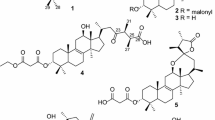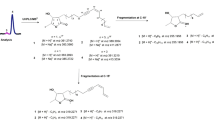Abstract
The bioassay-guided phytochemical investigation of the leaf extract of Serjania yucatanensis, a woody climbing plant endemic to the Yucatan peninsula, led to the identification of a mixture of a triterpene [lup-20(29)-en-3-one] and an oxygenated sesquiterpene (β-caryophyllene oxide), as that responsible for the originally detected trypanocidal activity in the organic crude extract. Results showed that the mixture of lup-20(29)-en-3-one and β-caryophyllene oxide is active against trypomastigotes of Trypanosoma cruzi (IC50 = 80.3 μg/mL) and inhibits the egress of trypomastigotes from infected Vero cells (when tested at 100 μg/mL) without being cytotoxic.


Similar content being viewed by others
References
Barrero A, Molina J, Oltra E, Altarejos J, Barragán A, Lara A, Segura M (1995) Stereochemistry of 14-hydroxy-β-caryophyllene and related compounds. Tetrahedron 51:3813–3822
Budzikiewicz H, Djerassi C, Williams D (1964) Structure Elucidation of Natural Products by Mass Spectrometry. Vol II: Steroids, Terpenoids, Sugars and Miscellaneous Classes. Holden-Day, San Francisco USA.
Camargo EP (1964) Growth and differentiation in Trypanosoma cruzi. I. Origin of metacyclic trypomastigotes in liquid medium. Rev Inst Med Trop São Paulo 6:93–100
Castro JA, Montalvo M (2006) Toxic side effects of drugs used to treat Chagas’ disease (American trypanosomiasis). Hum Exp Toxicol 25:471–479
Coll JC, Bowden BF (1986) The application of vacuum liquid chromatography to the separation of terpene mixtures. J Nat Prod 49:934–936
de Diego C, Avendaño C, Alcina A, Carrasco L, Elguero J (1988) Effects of heterocyclic analogues of triphenylmethane dyes against Trypanosoma cruzi. Ann Trop Med Parasitol 82:235–241
Durán R, Campos G, Trejo JC, Simá P, May F, Juan M (2000) Listado florístico de la Península de Yucatán. Impresiones Profesionales del Sureste, Mérida, Yucatán, México, 99 pp
Escobar P, Leal SM, Herrera LV, Martinez JR, Stashenko E (2010) Chemical composition and antiprotozoal activities of Colombian Lippia spp essential oils and their major components. Mem Inst Oswaldo Cruz 105:184–190
González J, Sagua H, Araya J, Loyola A, Morales G, Pereira J, Estrada M (1990) In vitro activity of natural products against the trypomastigote form of Trypanosoma cruzi. Phytother Res 4:1–4
Harvey A (2000) Strategies for discovery drugs from previously unexplored natural products. Drug Discov Today 5:294–300
Herrera N, Correa E, Cardona D, Archbold R, Torres F, Quiñones W, Velez I (2007) Estructura y actividad de sapogeninas triterpénicas. Scientia et Technica 13:87–90
Kumar S, Misra N, Raj K, Srivastava K, Puri SK (2008) Novel class of hybrid natural products derived from lupeol as antimalarial agents. Nat Prod Res 22:305–319
Marín-Solano N, Ordoñez-Calderon S (2008) Determinación de metabolitos secundarios volátiles y semivolátiles, y ácidos aristolóquicos en Aristolochia ringens Vahl. Universidad Industrial de Santander, Bucaramanga, Colombia, Tesis de Licenciatura, 94 pp
Newman DJ, Cragg GM (2007) Natural products as sources of new drugs over the last 25 years. J Nat Prod 70:461–477
O’Brien J, Wilson I, Orton T, Pognan F (2002) Investigation of the Alamar Blue (resazurin) fluorescent dye for the assessment of mammalian cell cytotoxicity. Eur J Biochem 267:5421–5426
Özek G, Demirci F, Özek T, Tabanca N, Wedge D, Shabana K, Hüsnu K, Duran A, Hamzaoglu E (2010) Gass-chromatographic-mass spectrometric analysis of volatiles obtained by four different techniques from Salvia rosifolia Sm., and evaluation for biological activity. J Chromatogr A 1217:741–748
Polanco-Hernández G, Escalante-Erosa F, García-Sosa K, Acosta K, Chan-Bacab M, Sagua H, Gonzalez J, Osorio L, Peña-Rodríguez LM (2012) In vitro and in vivo trypanocidal activity of native plants from the Yucatan Peninsula. Parasitol Res 110:31–35
Pulido MT, Serralta L (1993) Lista anotada de las plantas medicinales de uso actual en el Estado de Quintana Roo. México, Centro de Investigaciones de Quintana Roo, 106 pp
Rahman K, Nahar K, Khan M, Hasan C (2007) Phytochemical and biological studies of Nephelium longan. Bol Latinoam Caribe Plant Med Aromatica 6:68–72
Rodrigues-Coura J, de Castro SL (2002) A critical review on Chagas disease chemotherapy. Mem Inst Oswaldo Cruz 97:3–24
Rolón M, Vega C, Escario J, Gómez-Barrio A (2006) Development of resazurin microtiter assay for drug sensibility testing of Trypanosoma cruzi epimastigotes. Parasitol Res 99:103–107
Rosas LV, Cordeiro MSC, Campos FR, Nascimiento SKR, Januário AH, Franca SC, Nomizo A, Toldo MP, Alburquerque S, Pereira OS (2007) In vitro evaluation of the cytotoxic and trypanocidal activities of Ampelozizyphus amazonicus (Rhamnaceae). Braz J Med Biol Res 40:663–670
Sánchez-Medina A (2001) Phytochemical and pharmacological studies on some endemic yucatecan medicinal plants. PhD thesis, Universidad de Greenwich, Londres, 204 pp.
Setzer W, Vogler B, Schmidt J, Petty J, Haber W (2005) Isolation of cupanioside, a novel cytotoxic and antibacterial long-chain fatty alcohol glycoside from the bark of Cupania glabra. Planta Med 71:686–688
Setzer W, Stokes S, Bansal A, Haber W, Caffrey C, Hansell E, McKerrow J (2007) Chemical composition and cruzain inhibitory activity of Croton draco bark essential oil from Monteverde, Costa Rica. Nat Product Commun 2:685–689
Silva LH, Nussenzweig V (1953) Sobre uma cepa de Trypanosama cruzi altamente virulenta para o camundongo branco. Folia Clin Biol 20:191–208
Vera-Ku M (2003) Evaluación de la actividad biológica en plantas nativas de la península de Yucatán. MSc thesis, Centro de Investigación Científica de Yucatán, México, 175 pp
Vieira GM, Leite de Souza CM, Chaves MH (2005) Resina de Protium heptaphyllum: isolamento, caracterização estrutural e avaliação das propriedades térmicas. Quim Nova 28:183–187
WHO-World Health Organization (2000) Special Programme for Research and Training in Tropical Disease (TDR). Natural products for parasitic diseases. TDR News, 62,4.
WHO-World Health Organization (2010) Nota descriptive no.340. At: http://www.who.int/mediacentre/factsheets/fs340/es/. Accessed 15 July 2010.
Xiao JB, Chen XQ, Zhang YW, Jiang XY, Xu M (2006) Cytotoxicity of Marchantia convoluta leaf extracts to human liver and lung cancer cells. Braz J Med Biol Res 39:731–738
Acknowledgments
The authors wish to thank Paulino Cimá for technical assistance and the identification of the plant material. GPH acknowledges the support of Consejo Nacional de Ciencia y Tecnología (CONACYT), through its “Becas Mixtas” Program, to carry out a research stay at the University of Antofagasta. This work was supported by Project FOMIX-Yucatán (66262) and Programa de Cooperación Bilateral México-Chile.
Author information
Authors and Affiliations
Corresponding author
Rights and permissions
About this article
Cite this article
Polanco-Hernández, G., Escalante-Erosa, F., García-Sosa, K. et al. Metabolites from the leaf extract of Serjania yucatanensis with trypanocidal activity against Trypanosoma cruzi . Parasitol Res 111, 451–455 (2012). https://doi.org/10.1007/s00436-012-2861-6
Received:
Accepted:
Published:
Issue Date:
DOI: https://doi.org/10.1007/s00436-012-2861-6




